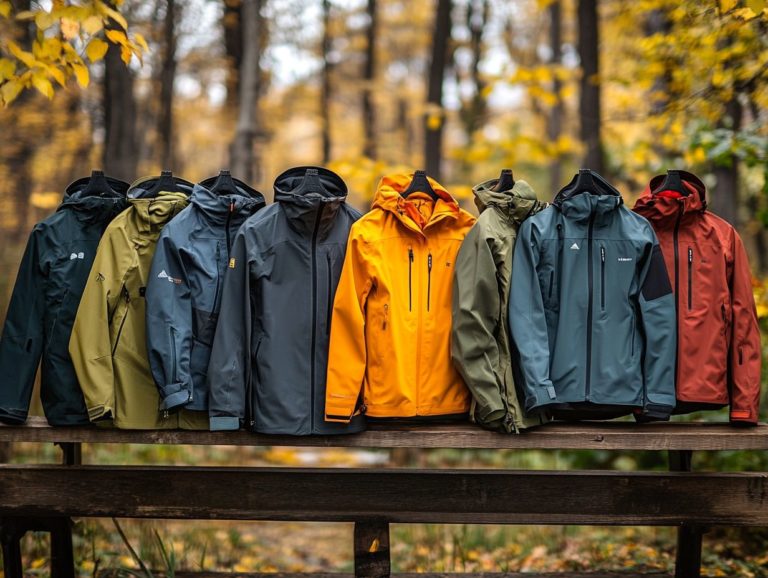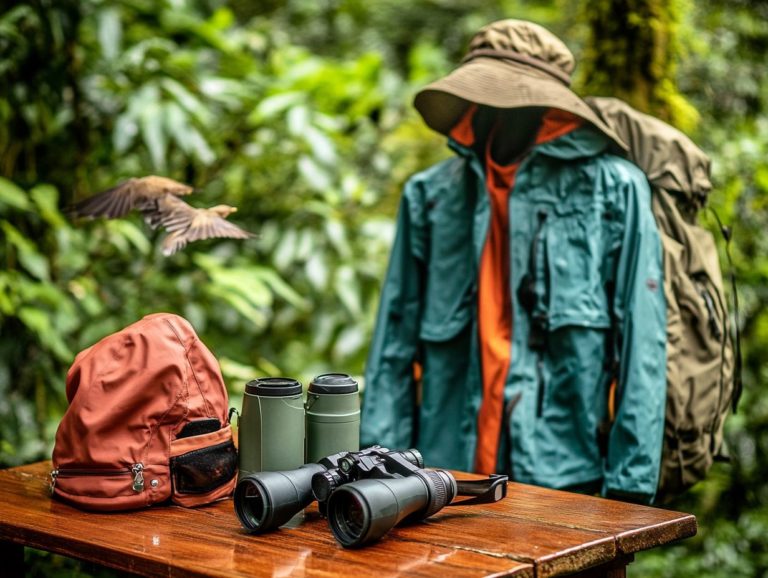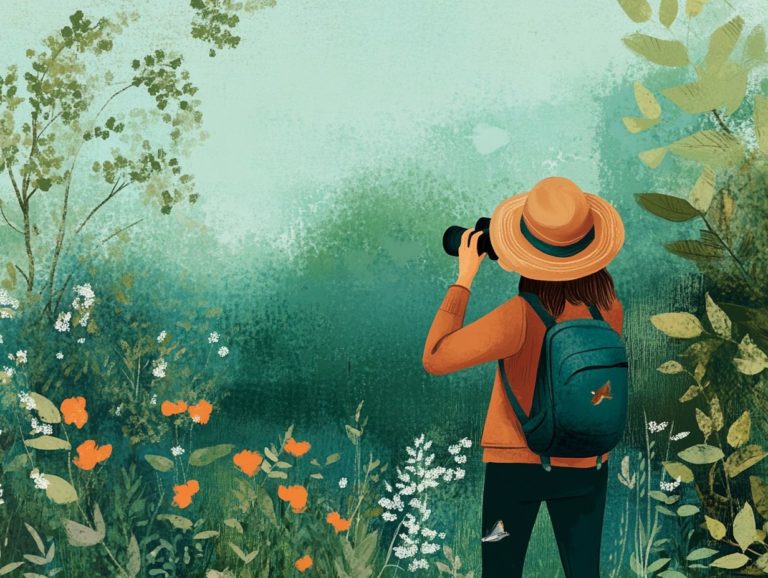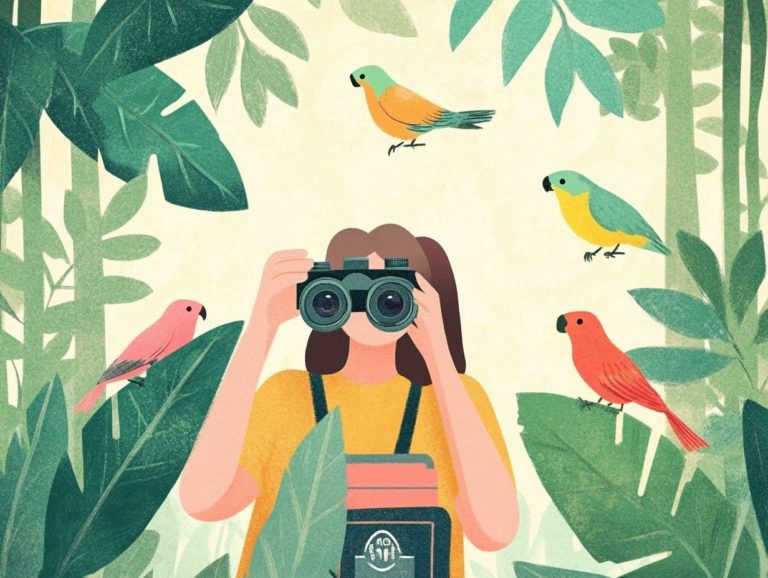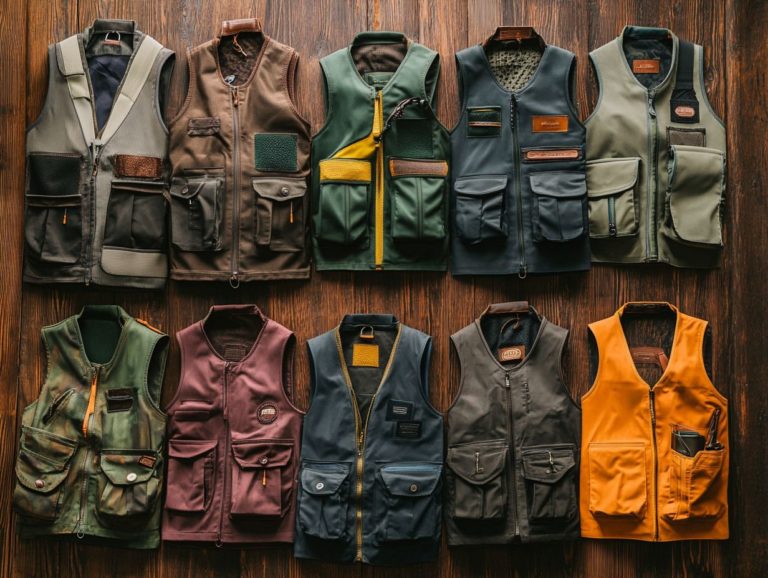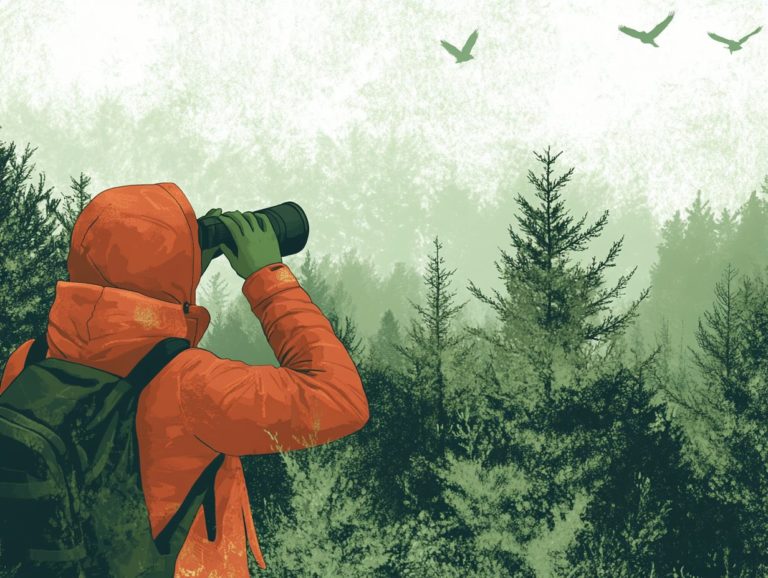How to Select the Right Gear for Birding in Winter
Birding in winter can be a truly enchanting experience, brimming with vibrant sights and sounds that few have the pleasure of witnessing.
To fully embrace this distinctive season, possessing the right specialized gear is essential. From high-quality binoculars and scopes to insulated clothing and reliable traction devices, each piece of equipment is vital for ensuring your comfort and safety as you venture into the great outdoors.
This guide will walk you through the essential winter birding gear, offer tips for selecting the perfect items, and prepare you for your outdoor escapades. Embrace the chill today and elevate your birding adventures!
Contents
- Key Takeaways:
- Why Specialized Gear is Necessary
- Essential Gear for Winter Birding
- Additional Gear for Comfort and Safety
- Tips for Choosing the Right Gear
- Preparing for Winter Birding
- Frequently Asked Questions
- What type of clothing should I wear for birding in winter?
- What type of footwear is best for birding in winter?
- Do I need to bring any special equipment for winter birding?
- How should I prepare my camera for birding in winter?
- Is it necessary to bring a spotting scope for winter birding?
- Are there any safety precautions I should take when birding in winter?
Key Takeaways:
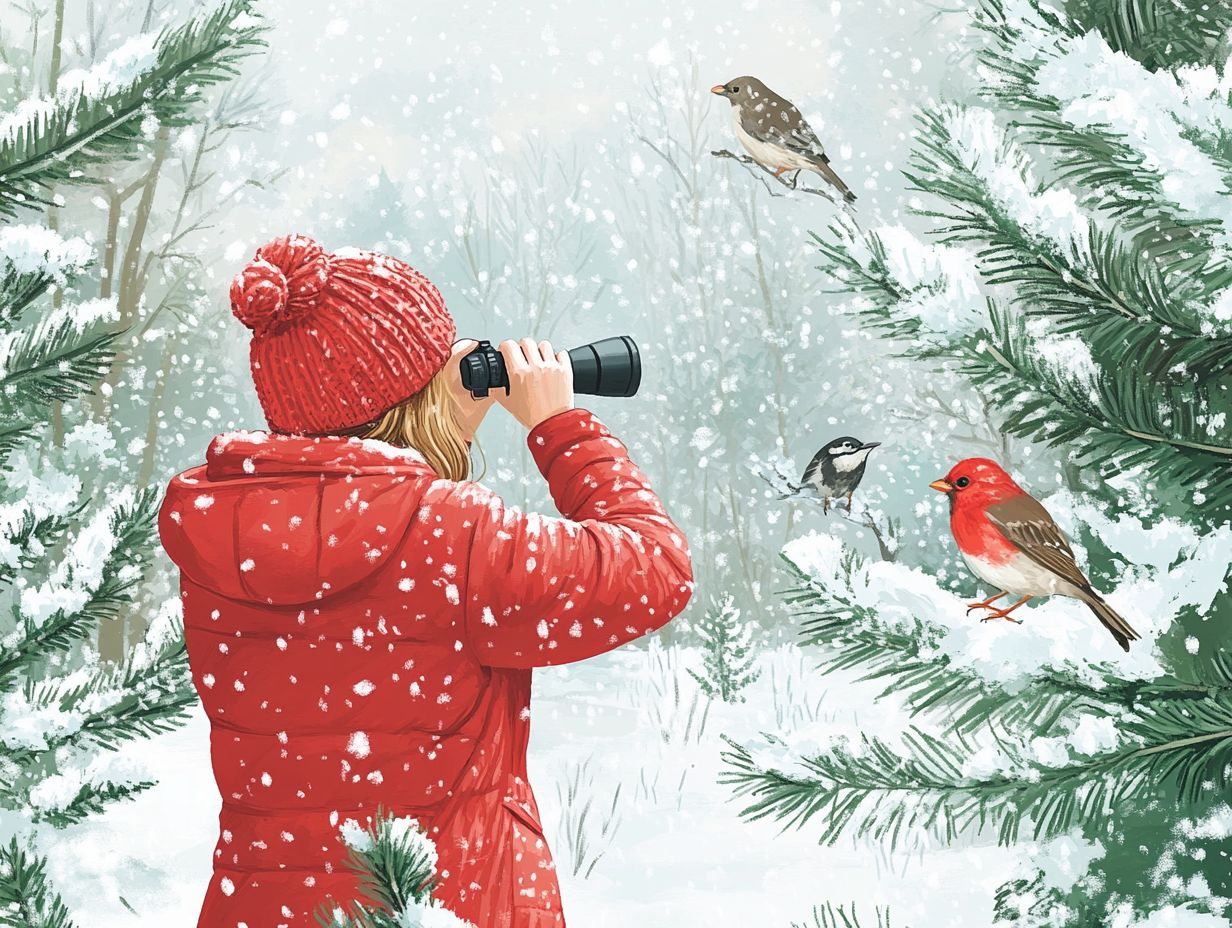
- Specialized gear is essential for successful winter birding due to the extreme weather conditions.
- Binoculars, scopes, and insulated clothing are must-haves for winter birding.
- Consider factors such as temperature, mobility, and comfort when selecting gear, like Fox River PrimaHike Crew socks and Rab Trek gaiters, which are lightweight waterproof. Plan and organize your gear beforehand to ensure a comfortable and safe birding experience.
Why Specialized Gear is Necessary
Birding in winter demands specialized gear to guarantee your comfort and safety in unpredictable Arctic conditions. The right gear, like the Muck Arctic Apres Lace boot, keeps you warm and stable on snowy trails.
You’ll appreciate features like a rugged sole that offers excellent grip for optimal traction. Choosing waterproof and fleece-lined apparel, like the Patagonia Nano Puff Bivy pullover, ensures you stay dry and warm. This enhances your experience as you track Bohemian Waxwings and other captivating avian species.
Essential Gear for Winter Birding
When you embark on a winter birding expedition, having the right gear is essential for your comfort and an optimal birdwatching experience. Start with a pair of high-quality binoculars to spot those distant feathered friends. Don t overlook the importance of Fox River PrimaHike Crew socks to keep your feet warm and cozy.
Rab Trek gaiters and Swix Banner gloves, featuring Thinsulate insulation (which keeps your hands warm without bulkiness), are critical for maintaining warmth in chilly conditions. A Nite Ize Inova headlamp is also a must-have for navigating low-light moments. To top it off, consider the Under Armour ColdGear Infrared Beenie; it s perfect for enhancing warmth, making it an excellent choice for birdwatchers braving colder climates.
Binoculars and Scopes
Choosing the right binoculars is essential for your birding adventures, especially when you’re on the hunt for elusive species like the Bohemian Waxwing in its winter habitat. High-quality binoculars help you spot and watch birds from far away, transforming them into a critical part of your birding kit.
Consider sunglasses like Smith s Guide s Choice with ChromaPop polarized lenses; these can reduce glare and enhance visibility, ensuring you maximize your time outdoors. With features such as anti-reflective coatings, waterproof and fog-proof designs, and ergonomic grips, these optical tools significantly elevate your viewing experience, especially in challenging winter conditions.
Opt for good magnification, typically ranging from 8x to 10x, to catch those intricate details like plumage patterns and color variations essential for identifying species in the field. If you’re after distant or elusive birds, scopes provide a more powerful option, allowing you to appreciate their behaviors and habitats on a much deeper level.
By arming yourself with the right optics, you not only sharpen your observational skills but also cultivate a richer connection with nature, making each outing an even more rewarding experience.
Insulated Clothing and Accessories
Insulated clothing and accessories, like the Swix Banner gloves with Thinsulate insulation, are essential for winter birding. They provide the warmth and protection you need against the elements.
Heading into the frigid outdoors with the right gear can transform your experience from uncomfortable to enjoyable. Proper insulation not only shields you from biting winds but also allows you to move freely. This freedom is crucial during long hours in the field.
Take a vest, for example. The Eddie Bauer Down Vest adds warmth without bulk, allowing you to easily maneuver while spotting elusive species.
High-quality hats, like the North Face Apex Flex Beanie, keep you warm and let moisture escape, which is vital during strenuous hikes. Every piece of gear boosts your comfort and lets you dive into the thrill of birdwatching, enabling you to focus on the beauty of feathered friends rather than the chill that threatens to intrude on your enjoyment.
Additional Gear for Comfort and Safety
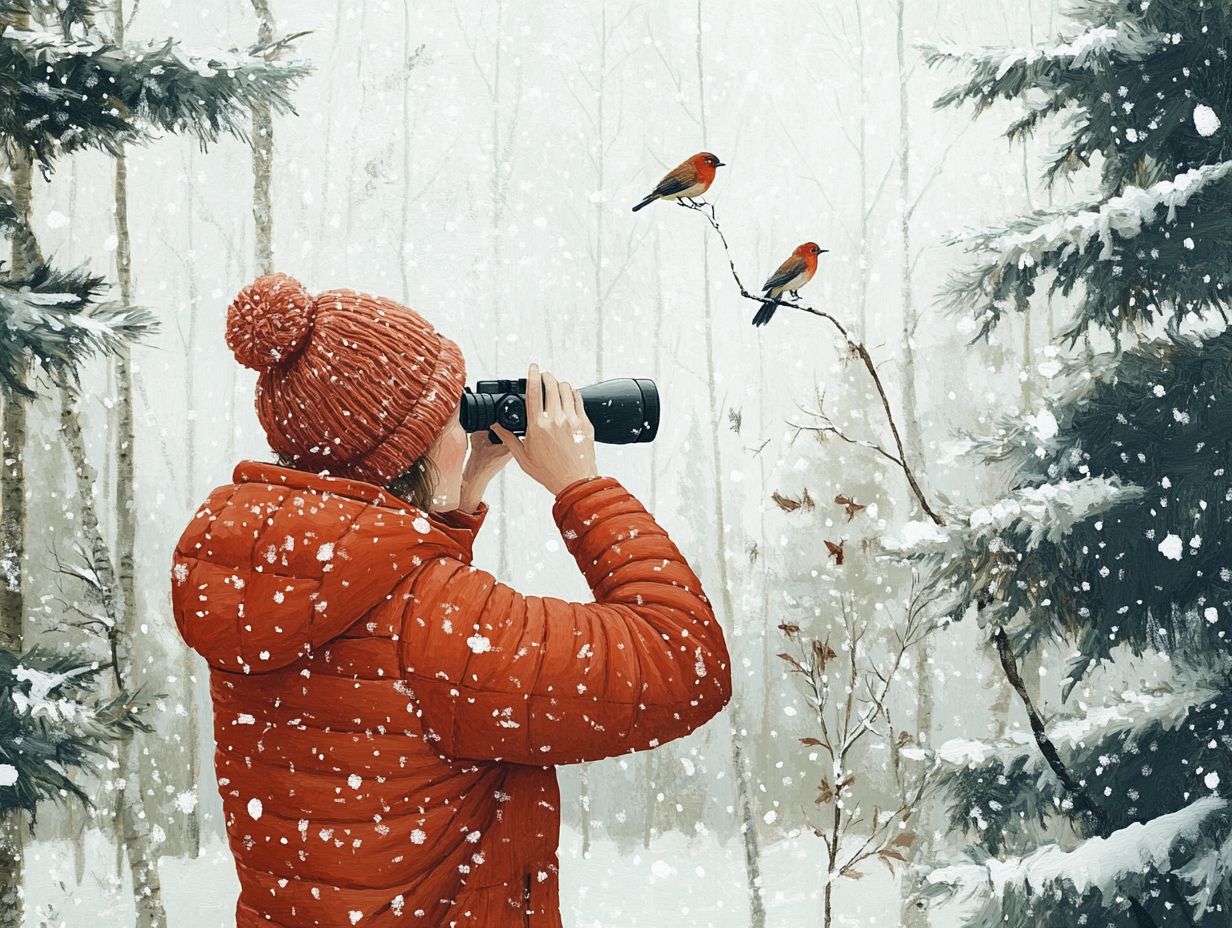
To enhance your comfort and safety on winter birding excursions, equip yourself with additional gear like hand and foot warmers and traction devices for snow and ice.
These thoughtful accessories keep you warm in frigid temperatures and provide stability on slippery surfaces, ensuring a safer exploration experience.
Using the Nite Ize Inova headlamp improves your visibility in low-light conditions. After a long day of birdwatching, slipping into Glerups slipper shoes wraps your feet in comfort.
Hand and Foot Warmers
Hand and foot warmers are essential companions for your winter birding adventures, providing warmth during chilly outings. Whether you choose disposable or reusable warmers, these accessories ensure comfort by warding off numbness and discomfort.
After a long day in the field, changing into Glerups slipper shoes offers a cozy reprieve for your tired feet.
Warmers come in various styles, including chemical, microwaveable, and battery-operated options to suit your preferences. Chemical warmers activate upon exposure to air, easily fitting into pockets or gloves. Reusable options are a sustainable choice, allowing you to avoid constant repurchase while still enjoying warmth. Battery-operated warmers offer adjustable heat levels for prolonged comfort.
After hours battling the cold, switching to soft and breathable Glerups slipper shoes not only banishes the chill but also provides exceptional support.
Traction Devices for Snow and Ice
Traction devices for snow and ice are vital for ensuring safety during winter birding adventures. These devices give you the grip needed on slippery surfaces, allowing you to navigate challenging terrains with confidence.
If you pair them with a Nite Ize Inova headlamp for enhanced visibility, you can effectively explore your surroundings, maximizing your experience even in low-light conditions.
Choosing the right traction device is crucial; options range from microspikes small traction devices that attach to your shoes to crampons, which are metal spikes for more extreme ice conditions. A quality headlamp not only illuminates your path but also helps you spot elusive species after sunset.
Don t overlook the importance of a reflective vest to enhance your safety. By combining these tools, you’ll be well-equipped to tackle winter landscapes and enjoy serene moments while observing nature’s avian wonders.
Tips for Choosing the Right Gear
Selecting the right gear for winter birding is essential for ensuring a successful and enjoyable experience. Begin by considering clothing options that are fleece-lined and waterproof, allowing you to stay warm and dry as you traverse snow-covered trails. Additionally, check out navigating bird watching gear options for all seasons for more tips on what to choose.
For footwear, choose options with a rugged sole that offers excellent grip. This is perfect for navigating slippery terrains. Prioritize insulation materials, like eco-friendly PrimaLoft, a lightweight material that keeps you warm without the burden of extra weight in your gear.
Factors to Consider
When selecting gear for winter birding, several key factors deserve your attention to ensure the best performance and comfort. First, prioritize materials that are fleece-lined and waterproof; these will keep you protected from the elements while ensuring you stay warm. Additionally, consider the top 5 accessories for bird watching in winter to enhance your experience.
Your footwear should feature a rugged sole with excellent grip to safely navigate icy surfaces. Consider insulation options like eco-friendly PrimaLoft, which offers warmth without sacrificing mobility.
Wearing layers can greatly enhance your versatility, allowing you to adapt to changing weather conditions throughout the day. Seek outer layers that are breathable yet windproof to manage moisture while blocking chilly gusts.
Don’t underestimate the importance of accessories. Insulated gloves and thermal hats are essential for preserving body heat. Binoculars with non-slip grips will ensure steady viewing even in less-than-ideal conditions.
A durable backpack makes your birding adventure so much easier! Ensure it has compartments for easy organization of your essentials. This thoughtful addition can make all the difference during long hours spent outdoors observing your feathered friends.
Preparing for Winter Birding
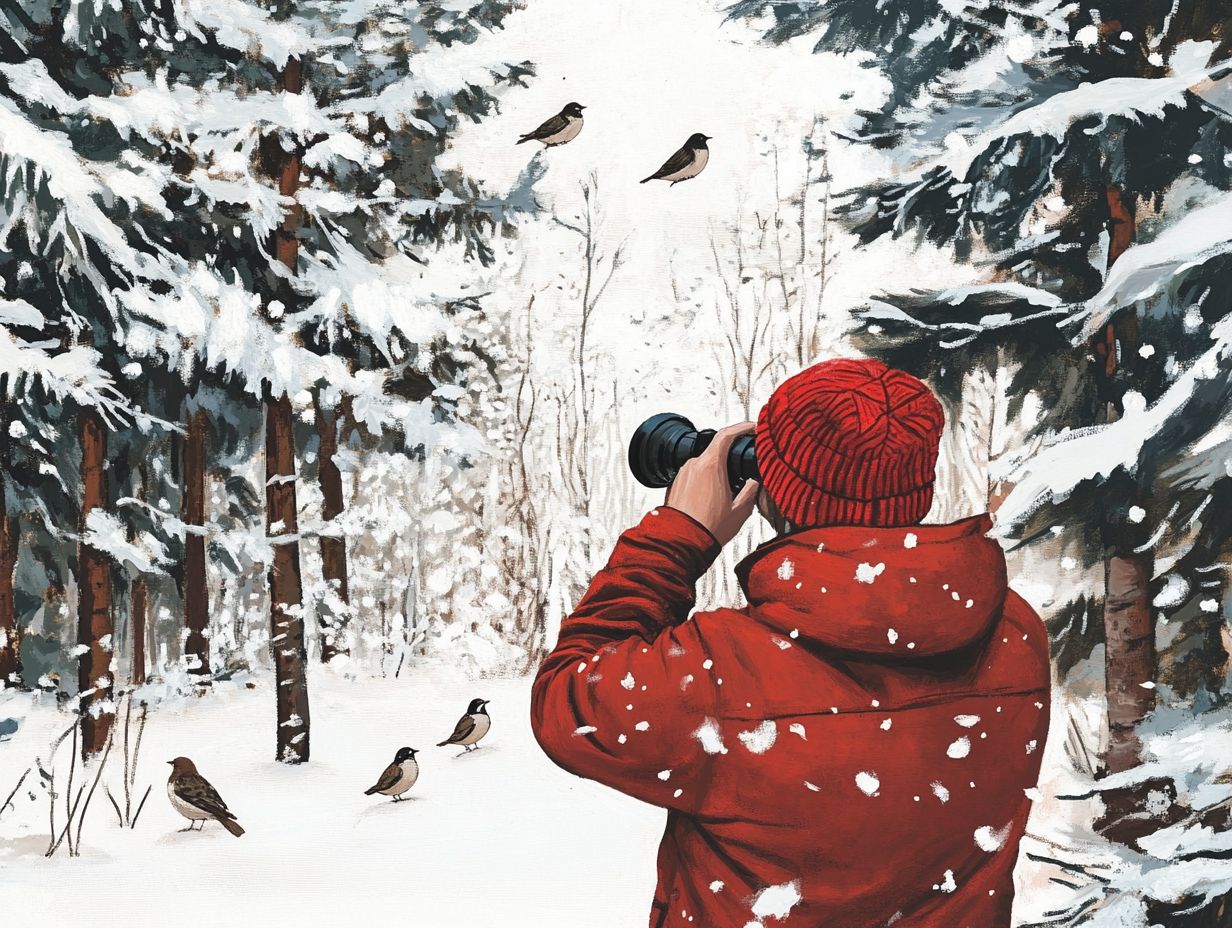
Preparing for winter birding requires meticulous planning and organization of your gear to ensure a seamless and enjoyable experience in the field. Begin by efficiently packing and organizing your essentials in your backpack for quick access to critical items while prioritizing comfort and mobility.
It s also prudent to include must-haves like the Under Armour ColdGear Infrared Beanie, ensuring warmth remains at the forefront of your priorities as you navigate through chillier landscapes.
How to Pack and Organize Your Gear
Packing and organizing your gear effectively is crucial for a successful winter birding expedition. Start by categorizing your items think clothing, optics, and accessories to ensure quick access during your outing.
Utilizing packing cubes or resealable bags can help you further compartmentalize your accessories, minimizing unwanted clutter. Prioritize lightweight yet insulated clothing so you stay warm without feeling like you re lugging around a heavy load.
Keep essentials like field guides and snack bars easily accessible in exterior pockets for those moments when you need them most. For your optics, a dedicated padded case for your binoculars is a wise investment, offering both protection and easy retrieval.
Thoughtful organization not only streamlines your experience but also enhances your enjoyment as you immerse yourself in the beauty of winter wildlife.
What to Wear for Optimal Comfort and Mobility
For optimal comfort and mobility during your winter birding adventures, selecting the right clothing and footwear is absolutely essential. Begin by layering fleece-lined waterproof garments to shield yourself from the cold, and consider the best gear for bird watching in humid conditions for those warmer days.
This layering approach ensures you stay warm without sacrificing movement.
Your footwear should feature a rugged sole with excellent grip, providing stability on those slippery trails. Consider insulation options like eco-friendly PrimaLoft, which helps maintain body heat without adding unnecessary bulk.
These essentials include moisture-wicking base layers made from synthetic materials or merino wool, which can significantly enhance your ability to keep warm. This allows sweat to evaporate, keeping you dry and warm even during the most vigorous activities.
Investing in gloves that offer dexterity will ensure you can handle your equipment comfortably. When choosing pants, opt for those with a bit of stretch for unrestricted movement. This can greatly elevate your overall birding experience.
Ultimately, by prioritizing functional materials and smart layering techniques, you can fully enjoy your time outdoors, feeling both comfortable and agile in the cold.
Frequently Asked Questions
What type of clothing should I wear for birding in winter?
When choosing clothing for winter birding, it’s important to prioritize warmth and comfort. Opt for layers of insulating materials such as wool or fleece, along with a waterproof and windproof outer layer to protect from the elements. Additionally, having the right photography gear essentials for birdwatching can enhance your experience in the cold.
What type of footwear is best for birding in winter?
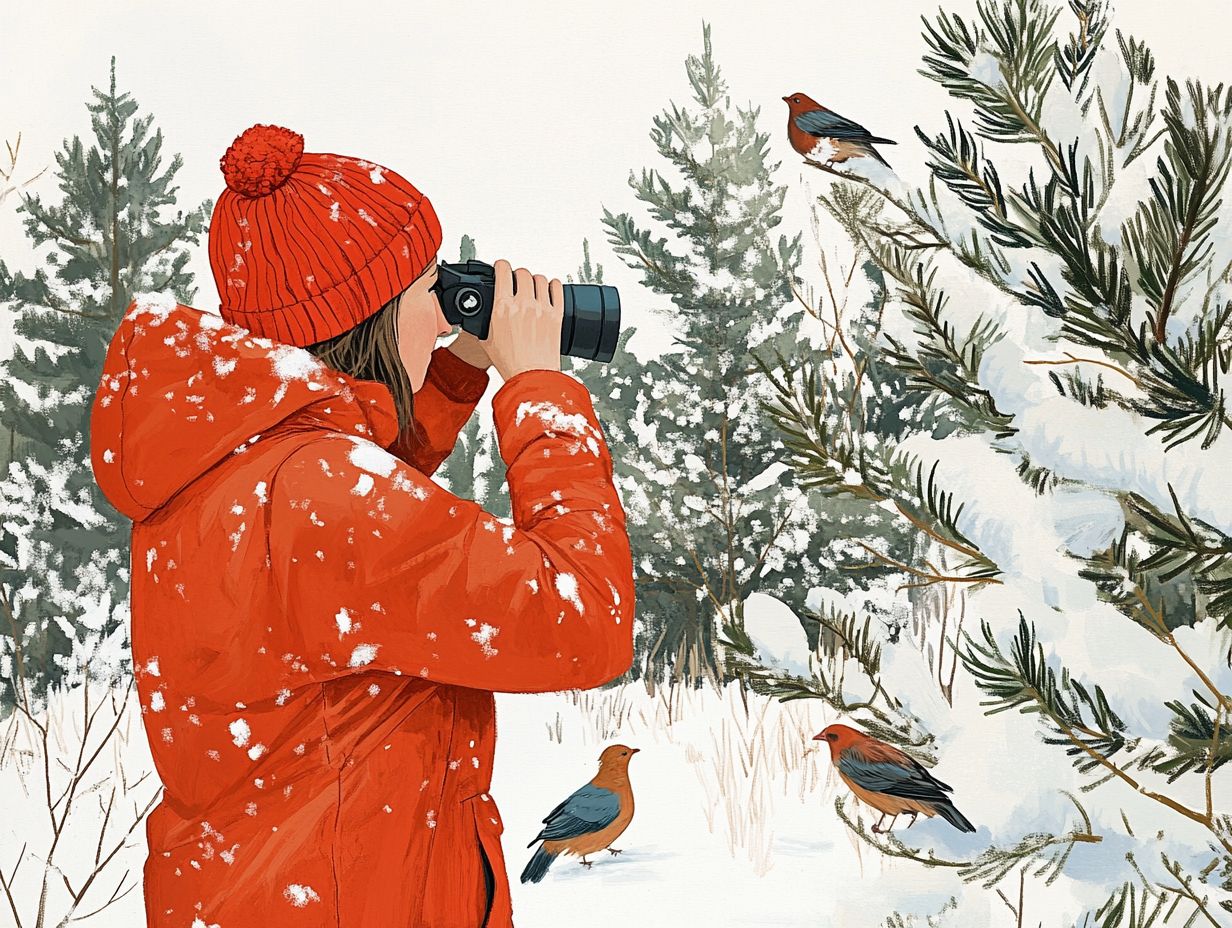
For winter birding, it’s best to wear insulated and waterproof boots with good traction. This will keep your feet warm and dry while navigating through potentially snowy or icy terrain.
Do I need to bring any special equipment for winter birding?
In addition to standard birding gear such as binoculars and a field guide, don t forget to bring hand and foot warmers, a thermos with a hot beverage, and a small first aid kit in case of emergencies.
How should I prepare my camera for birding in winter?
In cold temperatures, camera batteries can drain quickly. Pack extras and keep them warm by storing them in an interior pocket. You may also want to consider using a rain cover or protective casing to shield your camera from moisture and snow.
Is it necessary to bring a spotting scope for winter birding?
While a spotting scope can be useful for distant bird identification, it’s not always necessary for winter birding. However, if you plan on birding in open areas with large bodies of water, a spotting scope can help spot waterfowl and other birds in their winter habitats.
Are there any safety precautions I should take when birding in winter?
It’s important to dress appropriately and bring emergency supplies in case of any accidents or unforeseen circumstances. It’s also helpful to let someone know where you will be birding and when you plan to return. Always listen to your body and take breaks to warm up if needed.
Get ready for your winter birding adventure with the right gear!

